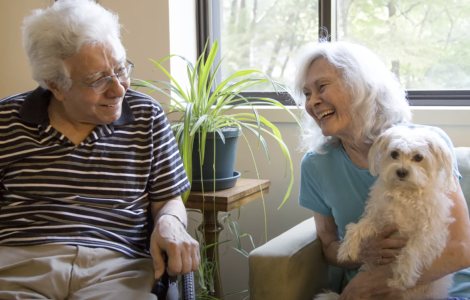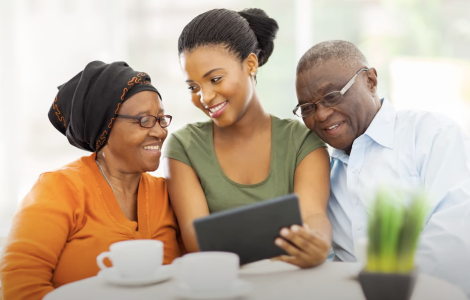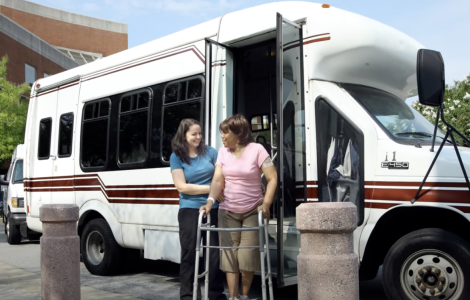You don’t have to be there to show you care: A senior’s guide to long-distance caregiving
- Replies 0
Long-distance caregiving: it’s a phrase that can send a shiver down the spine of even the most organized among us. If you’re reading this, chances are you’re already juggling the emotional and logistical challenges of caring for a loved one from afar—or you’re about to step into those shoes.
At The GrayVine, we know that while love knows no distance, caregiving sure does come with its own set of hurdles.
But take heart: with the right strategies, support, and a little bit of humor, you can make a real difference in your loved one’s life—without losing your own in the process.
The New Normal: Aging in Place, Caregiving from Afar
More and more older adults are choosing to age in place, cherishing the comfort and familiarity of their own homes. This trend means that millions of Americans—an estimated 5 to 7 million, in fact—are now long-distance caregivers, living an average of 450 miles away from those they support.
Whether you’re a few hours’ drive or a cross-country flight away, the challenges are real: anxiety, guilt, and the constant worry that you’re not doing enough.
But here’s the good news: you’re not alone, and there are proven ways to make long-distance caregiving work for everyone involved.
Building Your Caregiving Team: It Takes a Village (and a Group Chat)
The first step? Don’t go it alone. Successful long-distance caregiving is all about building a strong network—both on the ground where your loved one lives and back home for yourself.

This means family, friends, neighbors, health aides, and even professionals like geriatric care managers. Think of it as assembling your own superhero squad, each with their own special powers (or, at the very least, a willingness to check in or run an errand).
Family Meetings: The Power of Planning Together
Before you start booking flights or rearranging your life, gather the family—virtually or in person—for a candid conversation. What does your loved one need? Who can help, and how?
Be honest about your own availability and resources. Don’t forget to talk money: understanding the financial picture up front can prevent misunderstandings and resentment down the road.
Designate a primary point person (the 'quarterback,' if you will) to keep everyone informed and the plan on track.
And remember: responsibilities can be shared, even from a distance. Maybe you handle bill paying and medical appointments, while a sibling nearby manages groceries and in-person visits.
Creating a Local Support Network: Your Eyes and Ears on the Ground
If you’re not nearby, having trusted people close to your loved one is essential. This could be a neighbor who checks in, a friend who drives them to appointments, or a professional caregiver.
If your budget allows, consider hiring a geriatric care manager or eldercare coordinator—they can be worth their weight in gold when it comes to peace of mind.
For those with fewer resources, community organizations, faith groups, and local agencies on aging can help fill the gaps. Don’t be shy about asking for help; most people are happy to lend a hand.

Staying in the Loop: Health, Medications, and Appointments
Knowledge is power, especially when it comes to your loved one’s health.
Keep an up-to-date list of doctors, medications, and appointments, and make sure everyone involved has a copy. Post it somewhere visible in your loved one’s home, and keep digital copies for yourself and other caregivers.
Get written consent so you can speak with doctors and insurance companies. If possible, access your loved one’s online patient portal for real-time updates.
And don’t forget to educate yourself about their medical conditions—being informed helps you advocate effectively from afar.
Document Central: Keeping the Paperwork in Order
Legal and financial documents are the unsung heroes of caregiving. Make sure you know where to find (and have copies of) essentials like:
- Power of attorney (for health and finances)
- Last will and testament
- Trusts and advance directives
- HIPAA authorizations
- Insurance policies
- Banking and investment info
- Social Security and tax records
- Funeral and burial plans
Having these at your fingertips can save precious time and stress in a crisis.

Home Safety: Peace of Mind, One Grab Bar at a Time
Nothing keeps a long-distance caregiver up at night like worrying about falls or accidents. Take steps to make your loved one’s home as safe as possible:
- Clear walkways and remove tripping hazards
- Install grab bars in bathrooms
- Ensure good lighting throughout the house
- Use non-slip mats and secure rugs
- Keep clutter to a minimum
If you can, do a safety check during visits—or ask a local friend or professional to help.
Also read: Georgia family sues funeral home after heartbreaking mix-up: What went wrong and how to protect your loved ones
Communication: The Lifeline of Long-Distance Care
Regular, open communication is your best tool. Set up scheduled calls or video chats with your loved one, family, and caregivers.
Share updates, ask questions, and listen for any changes in mood or health.
Make sure everyone has a list of important contacts, and encourage honesty—sweeping problems under the rug only makes things harder later.
If your loved one is experiencing cognitive decline, adjust your communication style and involve professionals as needed. Family unity is key; present a united front and agree on next steps together.

Making the Most of Visits: Quality Over Quantity
When you do visit, make it count. Use the time to assess your loved one’s well-being, meet with caregivers, and tackle any outstanding tasks.
But don’t forget to simply enjoy each other’s company—watch a favorite movie, share a meal, or reminisce about old times.
Rotate visits with other family members if possible, and keep an eye out for signs of neglect or abuse.
Embracing Technology: Your Digital Caregiving Toolkit
From telehealth appointments to shared calendars and medical alert devices, technology can be a long-distance caregiver’s best friend. Consider:
- Video calls for check-ins and virtual doctor visits
- Electronic pill dispensers and medication reminders
- Remote monitoring (with your loved one’s consent)
- GPS trackers for those prone to wandering
- Smart speakers for reminders and companionship
Just remember: always respect your loved one’s privacy and autonomy.
Emergency Preparedness: Hope for the Best, Plan for the Worst
Have a plan for getting to your loved one quickly in an emergency. Know your travel options, keep a go-bag ready, and make sure your contact info is easily accessible.
Identify local support who can step in until you arrive, and keep a list of nearby hotels or short-term rentals.
Also read: 7 costly caregiving myths that could be draining your wallet
Adapting as Needs Change: Flexibility is Key
Care needs evolve over time. Be ready for ongoing conversations about health, finances, and living arrangements.
Sometimes, the best way to honor your loved one’s wishes is to help them transition to a new living situation or bring in more help at home.
Caring for Yourself: The Caregiver’s Golden Rule
You can’t pour from an empty cup. Long-distance caregiving is emotionally taxing—guilt, anxiety, and exhaustion are common.
Make self-care a priority: eat well, get enough sleep, and seek support from friends, family, or a therapist. Respite care and adult day services can give you a much-needed break.
And remember: perfection is not the goal. Do your best, accept your limits, and know that your efforts matter.
Long-distance caregiving is never easy, but it can be deeply rewarding. You may discover new strengths, deepen your relationship with your loved one, and create memories that last a lifetime.
As Allison Applebaum of Mount Sinai says, “Even if you are not on the ground, you’re still able to make a meaningful and important contribution.”
Read next: A caregiving crisis is growing across the US—here’s what families need to know now

Are you a long-distance caregiver? What strategies have worked for you? What challenges have you faced, and how have you overcome them? Share your stories, tips, and questions in the comments below!
At The GrayVine, we know that while love knows no distance, caregiving sure does come with its own set of hurdles.
But take heart: with the right strategies, support, and a little bit of humor, you can make a real difference in your loved one’s life—without losing your own in the process.
The New Normal: Aging in Place, Caregiving from Afar
More and more older adults are choosing to age in place, cherishing the comfort and familiarity of their own homes. This trend means that millions of Americans—an estimated 5 to 7 million, in fact—are now long-distance caregivers, living an average of 450 miles away from those they support.
Whether you’re a few hours’ drive or a cross-country flight away, the challenges are real: anxiety, guilt, and the constant worry that you’re not doing enough.
But here’s the good news: you’re not alone, and there are proven ways to make long-distance caregiving work for everyone involved.
Building Your Caregiving Team: It Takes a Village (and a Group Chat)
The first step? Don’t go it alone. Successful long-distance caregiving is all about building a strong network—both on the ground where your loved one lives and back home for yourself.

Long-distance caregiving is becoming more common as more older Australians choose to age in place, and having a strong support network–both locally for your loved one and for yourself–is crucial for making it work. Image source: John Hopkins Medicine / Youtube.
This means family, friends, neighbors, health aides, and even professionals like geriatric care managers. Think of it as assembling your own superhero squad, each with their own special powers (or, at the very least, a willingness to check in or run an errand).
Family Meetings: The Power of Planning Together
Before you start booking flights or rearranging your life, gather the family—virtually or in person—for a candid conversation. What does your loved one need? Who can help, and how?
Be honest about your own availability and resources. Don’t forget to talk money: understanding the financial picture up front can prevent misunderstandings and resentment down the road.
Designate a primary point person (the 'quarterback,' if you will) to keep everyone informed and the plan on track.
And remember: responsibilities can be shared, even from a distance. Maybe you handle bill paying and medical appointments, while a sibling nearby manages groceries and in-person visits.
Creating a Local Support Network: Your Eyes and Ears on the Ground
If you’re not nearby, having trusted people close to your loved one is essential. This could be a neighbor who checks in, a friend who drives them to appointments, or a professional caregiver.
If your budget allows, consider hiring a geriatric care manager or eldercare coordinator—they can be worth their weight in gold when it comes to peace of mind.
For those with fewer resources, community organizations, faith groups, and local agencies on aging can help fill the gaps. Don’t be shy about asking for help; most people are happy to lend a hand.

Open and honest communication among all family members and caregivers helps ensure everyone’s on the same page, makes managing care easier, and reduces the potential for family conflict. Image source: John Hopkins Medicine / Youtube.
Staying in the Loop: Health, Medications, and Appointments
Knowledge is power, especially when it comes to your loved one’s health.
Keep an up-to-date list of doctors, medications, and appointments, and make sure everyone involved has a copy. Post it somewhere visible in your loved one’s home, and keep digital copies for yourself and other caregivers.
Get written consent so you can speak with doctors and insurance companies. If possible, access your loved one’s online patient portal for real-time updates.
And don’t forget to educate yourself about their medical conditions—being informed helps you advocate effectively from afar.
Document Central: Keeping the Paperwork in Order
Legal and financial documents are the unsung heroes of caregiving. Make sure you know where to find (and have copies of) essentials like:
- Power of attorney (for health and finances)
- Last will and testament
- Trusts and advance directives
- HIPAA authorizations
- Insurance policies
- Banking and investment info
- Social Security and tax records
- Funeral and burial plans
Having these at your fingertips can save precious time and stress in a crisis.

Organization is key: keeping track of health information, important documents, and home safety measures helps you respond quickly and effectively to your loved one’s needs–even from afar. Image source: John Hopkins Medicine / Youtube.
Home Safety: Peace of Mind, One Grab Bar at a Time
Nothing keeps a long-distance caregiver up at night like worrying about falls or accidents. Take steps to make your loved one’s home as safe as possible:
- Clear walkways and remove tripping hazards
- Install grab bars in bathrooms
- Ensure good lighting throughout the house
- Use non-slip mats and secure rugs
- Keep clutter to a minimum
If you can, do a safety check during visits—or ask a local friend or professional to help.
Also read: Georgia family sues funeral home after heartbreaking mix-up: What went wrong and how to protect your loved ones
Communication: The Lifeline of Long-Distance Care
Regular, open communication is your best tool. Set up scheduled calls or video chats with your loved one, family, and caregivers.
Share updates, ask questions, and listen for any changes in mood or health.
Make sure everyone has a list of important contacts, and encourage honesty—sweeping problems under the rug only makes things harder later.
If your loved one is experiencing cognitive decline, adjust your communication style and involve professionals as needed. Family unity is key; present a united front and agree on next steps together.

Looking after yourself is just as important as caring for your loved one, so don’t be afraid to seek help, set boundaries, and use technology or respite services to manage your own wellbeing. Image source: John Hopkins Medicine / Youtube.
Making the Most of Visits: Quality Over Quantity
When you do visit, make it count. Use the time to assess your loved one’s well-being, meet with caregivers, and tackle any outstanding tasks.
But don’t forget to simply enjoy each other’s company—watch a favorite movie, share a meal, or reminisce about old times.
Rotate visits with other family members if possible, and keep an eye out for signs of neglect or abuse.
Embracing Technology: Your Digital Caregiving Toolkit
From telehealth appointments to shared calendars and medical alert devices, technology can be a long-distance caregiver’s best friend. Consider:
- Video calls for check-ins and virtual doctor visits
- Electronic pill dispensers and medication reminders
- Remote monitoring (with your loved one’s consent)
- GPS trackers for those prone to wandering
- Smart speakers for reminders and companionship
Just remember: always respect your loved one’s privacy and autonomy.
Emergency Preparedness: Hope for the Best, Plan for the Worst
Have a plan for getting to your loved one quickly in an emergency. Know your travel options, keep a go-bag ready, and make sure your contact info is easily accessible.
Identify local support who can step in until you arrive, and keep a list of nearby hotels or short-term rentals.
Also read: 7 costly caregiving myths that could be draining your wallet
Adapting as Needs Change: Flexibility is Key
Care needs evolve over time. Be ready for ongoing conversations about health, finances, and living arrangements.
Sometimes, the best way to honor your loved one’s wishes is to help them transition to a new living situation or bring in more help at home.
Caring for Yourself: The Caregiver’s Golden Rule
You can’t pour from an empty cup. Long-distance caregiving is emotionally taxing—guilt, anxiety, and exhaustion are common.
Make self-care a priority: eat well, get enough sleep, and seek support from friends, family, or a therapist. Respite care and adult day services can give you a much-needed break.
And remember: perfection is not the goal. Do your best, accept your limits, and know that your efforts matter.
Long-distance caregiving is never easy, but it can be deeply rewarding. You may discover new strengths, deepen your relationship with your loved one, and create memories that last a lifetime.
As Allison Applebaum of Mount Sinai says, “Even if you are not on the ground, you’re still able to make a meaningful and important contribution.”
Read next: A caregiving crisis is growing across the US—here’s what families need to know now
Key Takeaways
- Long-distance caregiving is becoming more common as more older Australians choose to age in place, and having a strong support network – both locally for your loved one and for yourself – is crucial for making it work.
- Open and honest communication among all family members and caregivers helps ensure everyone’s on the same page, makes managing care easier, and reduces the potential for family conflict.
- Organization is key: keeping track of health information, important documents, and home safety measures helps you respond quickly and effectively to your loved one’s needs–even from afar.
- Looking after yourself is just as important as caring for your loved one, so don’t be afraid to seek help, set boundaries, and use technology or respite services to manage your own wellbeing.
Are you a long-distance caregiver? What strategies have worked for you? What challenges have you faced, and how have you overcome them? Share your stories, tips, and questions in the comments below!






